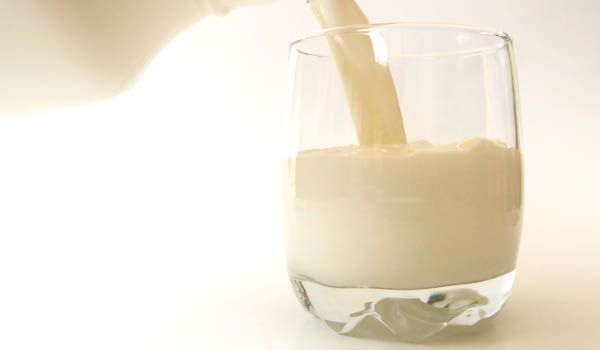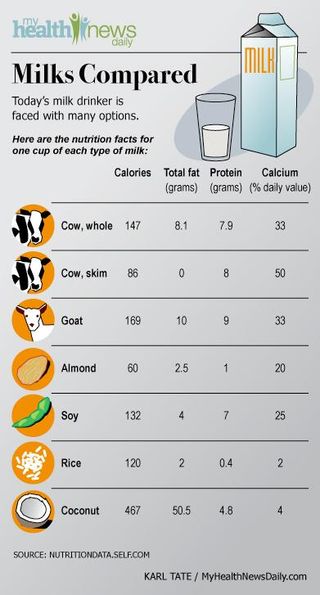The Skinny on Milk Nutrition: Cow, Goat, Rice or Soy?

When we were kids, milk was simple: we drank it with cookies and poured it into our cereal, and it always came from cows. But a dizzying array of milk choices are available today, many of which aren't actually milk at all but come from plant sources such as soybeans, rice and almonds. Some options, such as organic and raw milk, cater to personal dietary preferences. Others can help with health concerns such as lactose intolerance, the inability to digest the natural milk sugar called lactose. "There certainly are a lot of varieties out there, and each one brings to the table a different nutritional profile," said Jeannie Gazzaniga-Moloo, a spokeswoman for the American Dietetic Association. "Most of these products have been fortified with Vitamin D, which makes for a more even playing field when we go to choose," said Gazzaniga-Moloo, who is also a nutrition instructor at California State University in Sacramento. "Many nondairy alternatives do have a similar taste to milk, so for that reason they are good alternatives, especially if you have problems digesting lactose." How to decipher the options and decide which milk is best for you? Here's how they stack up nutritionally:

Cow's milk Pro: Hands down, cow's milk has the most calcium, and almost double the protein of any other type of milk. And because it comes in several types — whole, 2 percent, 1 percent or skim — that nutrition is accessible no matter which option is chosen. "It also has a more well-rounded nutritional profile," Gazzaniga-Moloo said. [Infographic: Milks Compared: How Do Milk Types Stack Up Nutritionally?] Con: Lactose intolerance affects a substantial number of Americans, causing abdominal pain, gas, bloating or diarrhea. But the condition doesn't mean it's necessary to go lactose-free. According to the National Digestive Diseases Information Clearinghouse, those with lactose intolerance can typically drink up to four ounces of milk several times a day without experiencing symptoms. But milk allergies still derail those plans for 2.5 percent of all American children, according to the American Academy of Allergy Asthma and Immunology. Fortunately, about 80 percent will outgrow the allergy before age 16. Soy milk Pro: Made by soaking soybeans and grinding them with water, soy milk is rich in protein and calcium and has no saturated fat. It also scores low in calories and comes in many flavors. "It's another good alternative for lactose intolerant people," Gazzaniga-Moloo said. Con: Soy products can inhibit protein and mineral absorption, offsetting its health benefits. "We still need more research to figure out where it's going to have its place," she said. Studies investigating soy’s role in breast cancer have yielded mixed results. Some findings suggest a substance in soy acts as a hormone in breast cells, fueling increased cancer risk.
Goat's milk Pro: A staple in much of the world, goat's milk is more easily digested by some because its protein molecules are sized differently than cow's milk. It packs as much calcium as whole cow's milk and contains more tryptophan, an essential amino acid. Con: Goat's milk contains lactose, eliminating it as a choice for some. And its distinct taste — a combination of sweet and salty — can be offensive, Gazzaniga-Moloo said, as can its strong odor. Almond milk Pro: Made from ground almonds mixed with water and sweetener, almond milk has become quite popular in the last several years, Gazzaniga-Moloo said. It shares several properties of dairy milk: Both have a wide variety of vitamins and minerals, and a comparable fat content. Almond milk also has a rich, nutty taste and comes in several flavors, making it an attractive alternative for those allergic to dairy or soy. Con: Protein is sparse in almond milk, with only 1 gram per cup, compared with 7 and 8 grams for soy and cow's milk, respectively. It's not suitable for those with nut allergies and lacks the B vitamins in cow's milk. Some almond milk has substantial amounts of sugar added, Gazzaniga-Moloo noted, making it worth a peek at each brand's ingredient list. Rice milk Pro: Made from ground rice, this type of milk is very low in fat and calories. It also comes in plain or vanilla flavors and is lactose- and soy-free. Con: Nutritionally, rice milk falls short compared with other varieties, Gazzaniga-Moloo said. It lacks Vitamins A and C, and contains very little protein. "It should rarely be chosen thinking it's going to provide some superior nutritional health benefit, because it's not," she said. Coconut milk Pro: Made from ground coconut meat and juices, this milk is rich, creamy and tasty and is a mainstay of Indian and Thai cooking. Its fats are more easily digested than those in dairy milks, Gazzaniga-Moloo said, and coconut milk is low in cholesterol. Con: Watch your waistline — coconut milk has a whopping 467 calories per cup. It's also low in calcium and protein and high in saturated fat. "We really have to take a look at the total calorie count and fat content," she said. "It's definitely an indulgence." Raw milk Pro: Proponents of raw milk, which is unpasteurized milk from cows, goats or sheep, bill it as "nature's perfect food," Gazzaniga-Moloo said, because it comes straight from nature with no processing. Con: Raw milk can harbor dangerous bacteria such as salmonella, E. coli and listeria. According to the U.S. Centers for Disease Control and Prevention, more than 800 Americans have gotten sick from consuming raw milk and its cheeses in the last 13 years. "It's certainly not a risk I choose to take," she said. "It can be a very passionate issue, but if people are going to choose raw milk, it needs to be an informed choice." Organic milk Pro: Passionate supporters of organic food and products appreciate that it was produced without growth hormones, antibiotics, pesticides or synthetic fertilizers. Con: The cost of organic milk is about double that of nonorganic milk because of its perceived health benefits. But in actuality, it's not significantly healthier than typical milk, if at all, Gazzaniga-Moloo said.
Follow MyHealthNewsDaily on Twitter @MyHealth_MHND
Sign up for the Live Science daily newsletter now
Get the world’s most fascinating discoveries delivered straight to your inbox.



